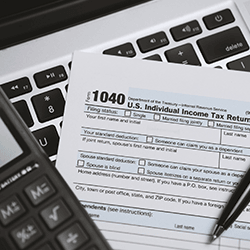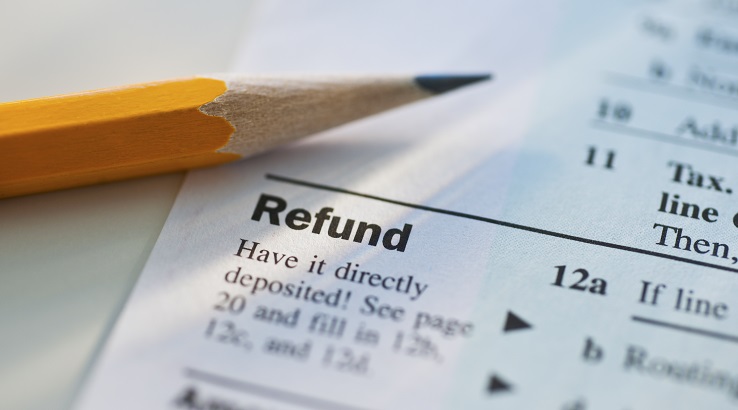
Federal income tax brackets for 2021-2022
Wondering how federal income tax brackets work? The US uses a progressive tax system, where the more you make, the more you pay. But how much you pay depends on your tax filing status.
The IRS deadline to file your 2021 tax return is April 18, 2022. If your taxes aren’t too complex, you may be able to file your taxes for free through tax return software or directly with the government. More complicated taxes involving multiple deductions or credits may require a fee.
No matter which option you choose to file, here’s a comprehensive guide on how to survive tax season without getting overwhelmed.
Depending on your specific tax situation, you’ll generally have three options when it comes to filing your taxes: print off your tax form and fill it out yourself, use a tax preparation software, or hire a tax preparer. Here are some things to consider when comparing your options:
| DIY | Tax prep software | Tax preparer | |
|---|---|---|---|
| Most cost-effective | |||
| Best for accuracy | |||
| Best for simple returns | |||
| Best for complicated returns | |||
| Best for guaranteed highest refund |
The first step in filing your taxes is to gather any information that proves you had income and deductible expenses for the year. Some common tax documents to gather include:
Most brand-name tax return software offer a free e-file version for simple taxes using Form 1040. If you own multiple assets, are claiming deductions or credits or are filing business taxes, you’ll want to make sure that the software you choose can handle your needs.
The US government offers a free option to file your federal tax return online through Free File. But you won’t receive guidance or instruction, so ensure you’re comfortable with your tax knowledge before choosing this tax filing option.
H&R Block, TurboTax and similar tax services take the guesswork out of filing your taxes. They walk you through how to fill out the various form fields and calculate whether you should take a standard or itemized deduction, so you can make sure you’re receiving your maximum refund. Prompts also cover life events and how they’re incorporated into your return, such as buying a house or car.
Most services scan your return to alert you of discrepancies or red flags that you might need to address before submitting your taxes. Review your tax return carefully and address any discrepancies the software flags to ensure everything is accurate. Once you’re ready, the tax software submits your forms to the IRS and forwards you tracking information on how to check in on your return.
Three out of four people get a tax refund each year. If you’re one of them, select how you want to receive your refund. Direct deposit is typically the quickest route, but you may have other options depending on which software you choose.
If you owe money, you can pay your bill directly through the online tax software. Most accept direct payments from your bank, credit or debit cards, checks and money orders. The IRS also offers installment agreements if you can’t pay your tax bill by the deadline.
To get an idea of how big your tax bill may be, view your state and federal income tax brackets.
Submit your return and pay any taxes owed by April 18th to avoid penalty fees. If you file for an extension, remember this gives you until October 17 to file your tax return only. Tax payments are still due on April 18th.
Here are several tax-filing services you can use from the comfort of your home.
Filing your taxes with a professional doesn’t have to be expensive. Here are five free tax prep options worth looking into:
Ultimately, your best route depends on how you’re able to answer three key questions:
If you’re looking to file your own taxes but want the benefits of professional help, consider a tax preparation software. It gives you the best of both worlds and most platforms come with a Maximum Refund Guarantee.
You should know based on your income and circumstances which category you fall into. But here’s a breakdown of the types of returns you may read about:
If you’re filing on behalf of a business or company, consider seeking professional advice to avoid running into trouble with the IRS.
There used to be three tax forms you could file as an individual: 1040EZ, 1040A and 1040. But now there are just two: Form 1040 and 1040-SR for seniors. Depending on your tax situation, you may need to use one of these popular tax forms when submitting your tax form:
Your taxes generally depend on how much you earn and how much you paid in taxes throughout the year, either deducted from your paycheck or paid quarterly, if you’re an independent contractor.
If you want to keep more of your paycheck throughout the year and aim for a $0 tax return, adjust your tax witholdings by submitting a new W-4 or W-4P with your employer.

Wondering how federal income tax brackets work? The US uses a progressive tax system, where the more you make, the more you pay. But how much you pay depends on your tax filing status.
Deductions and credits can chip away at how much the government gets to keep — and how much you’re able to keep in your own pocket. Let the $2,827 average individual tax refund for 2020 inspire you to suss out your qualified deductions.

Deductions can be personal and business expenses that you subtract from your total taxable income, effectively reducing the overall amount of tax you owe the government. The US uses a tiered tax bracket system, so the more you earn, the more you pay — deductions can help take the edge off.

Ready to file your taxes? Compare tax preparation software and decide which option is right for you.
The minimum income for filing taxes depends on your age and filing status. Here’s a breakdown of who must file their 2021 tax returns in 2022:
| Filing status | Minimum income |
|---|---|
| Single |
|
| Married filing jointly |
|
| Head of household |
|
| Married filing separately |
|
Specific people, like self-employed individuals, may still be required to file even if they make less than the minimum income threshold. And depending on your circumstances, while you may not have to file a tax return, there may be reasons that you would want to file a return, such as to qualify for a tax credit or to get a refund on withheld income taxes.
The standard tax return deadline is April 18th, and April 19th if you live in Maine or Massachusetts.
If you need more time to prepare your return, fill out Form 4868 by April 18th to request an extension . This gives you until October 17th to file your return but not extra time to pay your taxes. If you can’t afford to pay your entire tax bill at once, sign up for a payment plan, which will give you more time. However, if you end up owing taxes and pay after April 18th, you might be subject to the following late penalty fees:
You’re subject to penalties that include fees and even jail time. Your employer sends a copy of your payment information to the IRS too. So if you fail to file or pay, the IRS can calculate what you owe and start collecting interest on it.
If you’re worried about your tax situation, contact a tax professional to learn options specific to your circumstances.
If you file taxes online, expect to receive your refund within 21 days. If you file by mail, it could take as long as six weeks.
Track the status of your refund using the Where’s My Refund tool on the IRS website.
Everyone wants a giant refund come tax time, but it’s not as glamorous as you think. A big tax refund means you paid too much money to the IRS — money you could’ve been using each month to pay bills and cover unexpected expenses.
Likewise, a big tax bill means you didn’t pay nearly enough. Ideally, you should aim to break even each year. This is a goldilocks tax situation meaning you paid the right amount to the IRS.
If you want to avoid paying too much or too little taxes, adjust your W-4. This form tells your employer how much federal and state tax to withhold from each paycheck. If you’re currently facing a large tax bill, increase your W-4 withholdings. If you’re getting a giant refund, decrease your W-4 withholdings.
Adjust your W-4 at any time with your employer, but it’s better to do it as soon as possible. If you need help calculating how much you should withhold from each paycheck, use the IRS tax withholding estimator.
How do taxes work?
If you’re a paid employee with a regular paycheck, your employer withholds taxes on your earnings and sends them to the federal and state governments. But oftentimes you end up overpaying or underpaying in taxes by the time you account for tax deductions, credits and other sources of income. Filing your tax return helps you figure out if you paid too much or too little.
Who’s required to file a tax return?
If you’re at least 18 years old and can’t be claimed as a dependent on someone else’s tax return, then you can file a return each year. But whether you’re required to file taxes depends on your age, income type and filing status.
Generally, you don’t have to file taxes if your gross income is less than your standard deduction, but this only applies if you have regular income. If you’re self-employed, you have to file a return no matter what.
Even if you’re not required to file a return, you may want to do it anyway to take advantage of specific tax credits.
How do I deduct taxes on child care?
You may qualify for a tax credit of up to 35% for qualifying care for a child under the age of 13 or a dependent with a disability. Credits tend to top out at $3,000 for one child or up to $6,000 for two or more.
How do I file an extension?
File for a six-month extension using IRS Form 4868. Popular tax return software often offer extensions as part of their services.
How long should I keep my tax records?
It depends on your period of limitation. This is the amount of time you have to amend your tax return. For income taxes, you should keep your records for as little as three years and as long as forever.
Maximize your tax savings by having this 1099 expense tracker categorize business purchases for you.
Keep more of your money by aiming for a $0 tax refund from the IRS.
You could cut your tax bill by up to $7,500 with this credit.
Jackson Hewitt is a tax preparation service that lets you file simple returns online or more complex returns for a flat $25.
You need only $12.95 to file federal and state returns with this software.
Here are some rules around what you can claim in your tax return. See our checklist here and know what receipts you need to keep.
Tax breaks for US expats selling foreign real estate exist if you know where to look.
Find out if you classify as a 1099 employee, what it means to be 1099 and what it takes to stay on the level with the IRS.
H&R Block offers easy-to-use, quality tax filing services backed up by accuracy and maximum refund guarantees.
TurboTax is DIY tax preparation software with professional support so you can do your own taxes accurately, quickly, and affordably.
Hi there, I have one child and I made 14,300 for the year however I did not receive any w2 s because the work was under household employee and each of the jobs were under 2000? What can I get back in refund?
Hi Bonnie,
Thank you for your inquiry.
The average tax refund in the United States was $2,843 for individuals in 2014, but there is no guarantee you’ll receive this amount. Your refund depends both on your income bracket and also your withholding amount throughout the year.
Follow these steps to file your taxes:
Step 1: Choose an online provider to file with
Step 2. Sign up and begin your returns
Step 3. Double check everything before you submit
You can further check here at section “How do I submit my tax return online?”
I hope this information has helped.
Cheers,
Harold